#Rice Import Data
Text
#export duty#basmati rice export duty#non basmati rice export duty#rice export data#rice import data#seair#import export data#customs data#indian customs data
0 notes
Text
Philippines urged to boost up Local Rice Production
The Philippine economy is boosting its domestic production to reduce its dependence on imports. Major imported items include: electronics items, industrial machinery, consumer goods, and more.

0 notes
Text
The top exporters of basmati rice were India, Pakistan, China, Netherlands and Oman and the top importers of basmati rice were Iran, Saudi Arab, Iraq, UAE and USA. Download basmati rice buyers suppliers details here.
#Basmati Rice Export Import Data#Basmati Rice Exporters Importers Details#Basmati Rice Buyers Suppliers Details#Basmati Rice Custom Data#Basmati Rice Shipment Data
0 notes
Text
The Centre banned the export of broken rice & increased the export duty on rice by 20%

Recently, the Indian government took a bold decision to ban the exports of broken rice and add 20% duty on rice exports. This will impact the global market very badly as India is amongst the largest exporter of Rice. Indonesia and Philippines would be affected the most as they imports mostly from India and are dependent on Indian Rice exports.
The Indian Food Secretary, Sudhanshu Pandey justifies the ban on broken rice exports saying that the demand for rice exports was unusual. There was a significant increase in Indian rice exports. That led to soaring prices of rice in the domestics market. Earlier this year, the price for 1 Kg rice was Rs.15 that came up to Rs 22 in August month.
Also, due to bad rainfall, Indian rice production has been affected. As, the rice crop is cultivated in the kharif season and requires a lots of water for its growth. So, keeping these factors in mind, the government decided to ease the domestic market by putting the ban on broken rice exports.
Also, you can read about the detailed Indian rice exports statistics from the leading global import export data provider, Exim Trade Data Blog.
#ban on broken rice exports#broken rice export data#Indian rice exports#global import export data#global import export data provider#exim trade data#india export data#exporter of india#export of india#India import data#India trade statistics#India export import data
0 notes
Text
The standard legend of India’s Green Revolution centers on two propositions. First, India faced a food crisis, with farms mired in tradition and unable to feed an exploding population; and second, Borlaug’s wheat seeds led to record harvests from 1968 on, replacing import dependence with food self-sufficiency.
Recent research shows that both claims are false.
India was importing wheat in the 1960s because of policy decisions, not overpopulation. After the nation achieved independence in 1947, Prime Minister Jawaharlal Nehru prioritized developing heavy industry. U.S. advisers encouraged this strategy and offered to provide India with surplus grain, which India accepted as cheap food for urban workers.
Meanwhile, the government urged Indian farmers to grow nonfood export crops to earn foreign currency. They switched millions of acres from rice to jute production, and by the mid-1960s India was exporting agricultural products.
Borlaug’s miracle seeds were not inherently more productive than many Indian wheat varieties. Rather, they just responded more effectively to high doses of chemical fertilizer. But while India had abundant manure from its cows, it produced almost no chemical fertilizer. It had to start spending heavily to import and subsidize fertilizer.
India did see a wheat boom after 1967, but there is evidence that this expensive new input-intensive approach was not the main cause. Rather, the Indian government established a new policy of paying higher prices for wheat. Unsurprisingly, Indian farmers planted more wheat and less of other crops.
Once India’s 1965-67 drought ended and the Green Revolution began, wheat production sped up, while production trends in other crops like rice, maize and pulses slowed down. Net food grain production, which was much more crucial than wheat production alone, actually resumed at the same growth rate as before.
But grain production became more erratic, forcing India to resume importing food by the mid-1970s. India also became dramatically more dependent on chemical fertilizer.
According to data from Indian economic and agricultural organizations, on the eve of the Green Revolution in 1965, Indian farmers needed 17 pounds (8 kilograms) of fertilizer to grow an average ton of food. By 1980, it took 96 pounds (44 kilograms). So, India replaced imports of wheat, which were virtually free food aid, with imports of fossil fuel-based fertilizer, paid for with precious international currency.
Today, India remains the world’s second-highest fertilizer importer, spending US$17.3 billion in 2022. Perversely, Green Revolution boosters call this extreme and expensive dependence “self-sufficiency.”
106 notes
·
View notes
Text

ılı.lıllılı.ıllı.
now playing ► KINKTOBER 22, second week.
OVERVIEW. he is much worse better than you thought.
♫ SONG DURATION.
0:00 ——◦———— -2.5kwords
parental advisory ! explicit content
LYRICS. boss!employer, office, clothed sex, semi-public setting, enemies to lovers, orgasm denial, multiple orgasms, rough, manhandling, size kink, fingering, stockings, creampie, pet names, sound restraint, unprotected, strong language.
ᴠᴏʟᴜᴍᴇ : ▮▮▮▮▮▮▯▯▯
— the playlist

fear of men, more like a desire to avoid them, there were comprehensible reasons. that included, more specifically, directly and shamelessly honesty in wishing to stay away from that man, the one in charge of you, kento nanami. what a complete cold, rude and snobby attitude he has, you thought. he gives me so much work, it’s impossible to finish on my shift!, you complain. fuck him, such a jerk. you insulted on your head all over again, in a very constant and, perhaps daily, trail of thought. that blond-hair that whenever you saw, sent horrific shivers down your spine, followed by a not very discrete sigh from your lips, a snort or even maybe, clicking your tongue. nanami, your boss, surely was a man of few words, choosing ambiguously wisely, well, in a very direct way — maybe a little too straightforward — and so, coming off as an asshole sometimes, which infuriated your nerves. definitely, your efforts were higher than most of the workers there, yet, he did not recognize it, ever, no one’s efforts — it is your duty, if you’re unsatisfied, resign. yeah, harsh, his word. with a pile of never-ending papers of data, skimming through the numbers, letters and symbols with a dizzy head, stiff fingers from the repetitive typing, working overtime, again. throughout the day, with the same rhythm, no accumulated tasks and even so, you had to work until late at night, watching your workmates leave, with dark circles under their eyes but still, sharing how much they were going to eat after that, ramen, beer, rice, something as small as an oniguiri made your mouth salivate — curse him, making you go through that suffering, that torture. now, the lights were off, only the city outside, the hallway and your bright, blinding screen were a part of the scene, making the space a bit more visible, barely. worse was, being so focused on the priorities, thinking the other person across the cubicles of the office wasn’t anyone important…
“y/n, please, come here.” jolting at the sudden break of the silence — exempting the sirens and horns from outside, keyboard, air conditioner and the machines — a voice, a familiar one called. your curious eyes peeking over the white low walls, standing up fully, taking steps at the direction of the speaker, high heels tapping, echoing lowly. i thought he hated working overt—
“you do know i hate working overtime.” effortfully, attempting to contain yourself from rolling your eyes back.
“yes, i am well aware of that matter.” if someone could see your face, they’d say you must have woken up on the wrong side of bed. he took off his glasses, cleaning them with a cloth, then staring back at you with that same old quite angered expression, like yours, a very tense atmosphere, as usual.
“then, tell me why haven’t you been able to finish your work? you do know i am your supervisor, if the important tasks, given to you, are not done, those become my responsibility.” rude. even standing a bit farther from him, from a higher angle, that made yourself feel so much smaller, intimidated.
“well, if you hadn’t given me so much to d—
“it’s your work, i have mine, if you do yours, we will avoid this situation.” putting his glasses back on, he focused on the screen in front of him, typing for a few seconds. “don’t get your personal feelings involved on this matter, be a professional.”
“i’m sorry?” you question, confusedly mad, making the man pause, glance at you with his head titled slightly towards your direction.
“i acknowledge your dislike for me.” good, at least he’s self-aware. “i am simply doing my job, i see you take my sincerity as an offense.” you restrain yourself, doing the upmost to keep quiet, to be mature.
“well, nanami, if you weren’t such a— beep beep
the fax machine starts, gosh, that thing saved your job. watching the blond stand up, walk towards the big equipment with slow movements, seeming tired, perhaps. doing whatever was needed, heading to where you stood, without a care in the world and, setting the paper on his desk, yet, not sitting back down.
“what were you saying?” his almost adenoidal voice asked, as if teasingly, he knew where you were getting at. supporting himself with a hand on the surface, staring at you, expressionless.
“nothing.” stares, the eye contact was intense. a few seconds later, his head looked down, hearing a sigh come from him, his fingertips removed his glasses for real, now, laying them on the table. Your breath hitched as you noticed the distance between you both had been way closer than you’d thought.
“you surely are a piece of trouble, it even feels like i am your enemy,” crossing his arms and legs. “mrs. y/n.” because you are.
“are you done lecturing me, again?” there was a twitch in his lips, almost like a curve forming, your heart skipped a beat.
“no.” simple like that. it wasn’t fair, how he approached you, even if you felt rage inside, that could not be enough to make you push him away. closing in, inch by inch, putting you on a narrow spot, where you have your lower back against the desk, holding onto the borders, his body so proximal, yet not touching at all.
“what are you doing?” you nervously question, feeling your cheeks warm up.
“i have no sentiment of hatred against you, even if it seems like it,” such a calm voice. “in fact, what i dislike are your methods, more so, who you are at work.”
“that didn’t change anything.” the air felt heavier.
“it did, i never said i hated who you really are, since i don’t know her,” his breath was fresh, burning against your skin, a very noticeable difference in heights. “but you,” he paused. “you can’t say the same.”
“that’s right,” oh, a chuckle from him. your heart skipped a beat, again, dammit. the blond leaned down, a tiny bit, getting closer, so close his eyes felt like devouring you, until you noticed his hands beside your waist, but on the desk, enclosing your body even more. “i, hate….” lips so very close. “you…” touching barely. “nanami.” softly kissing, yet harsh at first, the contact was a perfect fit. the kiss had endured a few seconds, those seconds felt like nothing, until you were the one pulling away.
“doesn’t seem like it.” if you could, you’d punch him in the face, never even wanting to think about how red your cheeks must have been, because you know they were burning. his mouth leisurely moving close to your ear, both his hands latched onto your waist delicately, shivering as those same palms brought your hips against his crotch. “will you let me fuck this hatred out of you, darling?” whispering so very softly, it damaged your poor heart — which beat sped up even more.
“want to see you try.” words slipped out, slightly feeling his smirk against your skin, suddenly being put to seat on the desk, where there was an empty space and, nanami swiped off whatever could be in the way. another kiss, a fierce one, the man fondled your ass, with a gasp you left, then, he could easily slip his tongue inside your mouth and start leading. his fingers snook under your skirt, having your legs wrap around him, it was easy to lift you off the table and, unexpectedly, rip off your stockings, having you choke. “those were my favorite!” you complained breathless, in between pecks.
“i’ll buy you a new one, sweetheart.” feeling a breeze against your skin, you sinked back down the surface. those long fingers of his right hand, now instead, made their way to your shirt, still supporting yourself on the border of the wood below you and, all while he almost devoured your lips. unbuttoning so skillfully the small dots of your white collared shirt — the one that fit perfectly, made your body look absolutely even more gorgeous — until your lacy black bra was on sight, having him pull away for a second and, shamelessly stare at your chest, smiling truthfully, not taking off your shirt entirely, but was open enough to expose your torso. “that’s sweet.” you couldn’t decipher what he truly meant and, even if you could, he did not let you, after joining your lips once more, passionately. those digits now finding their way under the fabric, pushing it down, letting your breasts free over the bra, playing with a nipple surprisingly and, spontaneously letting out an unwanted moan. you were the one pulling away now, too ashamed to stare back at him, head to the side, covering your eyes with your forearm, noticing how the bulge on his pants was in contact with your inner thighs. he decided to stop, spreading your legs further apart, loosening his tie with a heavy breathing that made his features soften, unzipping his pants with the other hand. nanami reached now to your thighs, running his hands until the hem of your panties, since your skirt had been lifted to your hips quite some time ago, finishing to rip off the pantyhose you wore, as well as, pushing aside the cotton fabric of the lacy underwear matching your top and, your own hand flew to his wrist as soon as he played with your folds. “are you embarrassed for being this wet?” the blond questioned, noticing how you tried to stop him.
“shut up.” he smirked softly, again. lubricating his fingers enough and, so quickly, that it was easy to slid two of them inside your pussy, without warning, clenching your walls and attempting to squeeze your legs shut, however, he kept them open. your mouth morphed into an o shape, throwing your head back in ecstasy. “don’t tell me you’ve came already.”
“i-i didn’t.” liar, what a silly lie, you haven’t had sex in years. pushing them deeper in, you tried hard to keep quiet, it worked, for now. still tightly gripping onto his arm and wrist, so ashamed of the situation, your toes curled and heels were about to fall off from your feet, while nanami’s chest was heavily and seductively going up and down. thrusting those in and out painfully slow, curling them when he was all the way through, calloused wide and long fingers, he acted as if prioritizing your own pleasure first — he would never do that, would he? he’s just a selfish prick that… fuck — hitting that one spot led you to the edge, lips parted again, a low, very very low whine escaped and your grip tightened, yet, he knew he had found it.
“you’re very sensitive, mrs. y/n.” don’t say my name or i’ll… his tired eyes had an unexpected warmth to them, differently than usual, there was even this strange feeling that he was so needy and caring, his cheeks were faintly red, even if the lights were low, you could see that. with a more than perfect thrust of his fingers, such a pretty whine left your lips, so lewd, meanwhile, so innocent, not a hint of fakeness, nor dislike. and, with your back arched a little more, biting onto your lower lip, discrete trembling legs, you had came once more, a bit harder than before, squelching noises becoming louder, but before that, nanami’s head fell onto the crook of your neck, his nose against your skin. “i can’t take it anymore,” pulling out of you, he grabbed onto the sides of your hips, slowly leaning back, inches away from your face. “i need to fuck you.” with that, kissing again, like it was familiar already, like he was famine, with insatiable hunger for you. nanami, once more, like before, spread your legs apart, getting in between them, your arms wrapping around his wide shoulders. so very suddenly thrusting inside, with a cock you’d never imagine could be that big, immediately failing to keep silent, yet you kept on trying. pausing to take each breath, he faltered, with chopped short breaths, recomposing and pounding for the first time deep enough to maintain your legs shaking. one of his hands rested against your lower back, the other, held one of your thighs, bringing it closer to him. those were harsh, long pounds, ones that could easily break you in half if you were a porcelain doll. the pace was rough, but even, with a slight hint of gentleness. his groans were audible, your ego was flushed down the sink, which meant your whining was all over the place now, you gave up — he was treating you nice, there was no reason to stay quiet — and those sounds were soft, so sweet, so pretty, his cock seemed even bigger inside, your gummy walls clamping him tighter, hardly letting him breath.
“you fucking b-bastard,” dizzy, breathless, aroused and with tits jolting along your entire body at each of his forceful and precise thrusts. “it feels s-so good.” praising rudely, in between the pecks of his lips against yours, finding his way into also kissing your cervix.
“i know, sweetheart, i know.” his voice soothed your anger, which made you even more irritated, which contrasted with the puppy expression in your pretty face. pulling your body closer, with a more concentrated, methodical pace, the one that led you to moan even louder, to hear this man whine so desperately, to have you repeat a number of no!no!ngh-n-no!s, trying to convince yourself this was not the best fuck in your entire life — who would have thought, your boss, the one you hated, that treated people so badly, could do this to you. your nails digging over his social shirt, the one unbuttoned to the top of his chest, seeing a droop of swear rolling down, making his fragrance stronger. instinctively, arching your back, while being both penetrated by his cock, balls deep, jolting body, embraced by his arms pulling your hips at each slapping contact. a familiar feeling on your lower belly, clenching down even more, moaning so loudly it echoed, being kissed all over your neck, with his soft lips.
“‘m gonna cum!” effortfully advising, trembling.
“go on, please, do it for me, darling.” gripping the back of his hair, pulling him into a last kiss before his sloppy pounds made you cum another time, so good that it sent electric sparks all over your body, beginning to get so dumb for his cock that if he kept it that way, you’d even tell blurt out you loved him. followed by you, repeated fucks left nanami’s mouth, very serenely and lowly until there was just this sudden warmth filling you up, thrusting one last time, and a white ring on the base of his cock, staying in position for as long as he could last. in an instant, it flew by, only noticing his missing comfort as he slid out of your cunny. but, well, the man was not hesitant to push two of his fingers inside you, keeping his cum stored safely inside. “consider it your salary advance.”

🔖: @ryumiii @shi-thats-kiera @witheldclouds @jeanswife101 @doumalover @drpepperlov3r @bontensbabygirl @cozydeku @simp-lauren @fatenpara @cookieempress2 @call-me-pretty-and-nasty
#anime#jujutsu kaisen#jjk#jjk nanami#nanami kento#kento nanami#jjk kento#jjk kento nanami#jujutsu kaisen nanami#nanami x you#nanami x reader#nanami x y/n#kento nanami x you#nanami kento x you#nanami kento x reader#jjk x reader#jujutsu kaisen x reader#jujutsu kaisen x y/n#jjk x y/n#nanami kento x y/n
438 notes
·
View notes
Text
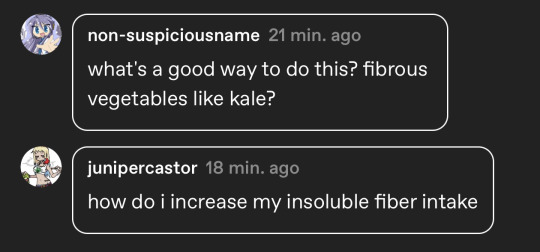
@non-suspiciousname @junipercastor i’m not a dietician or doctor disclaimer disclaimer if you have preexisting conditions this may not be for you disclaimer disclaimer i cannot account for every human experience disclaimer disclaimer BUT the easiest way to do this is to first learn what “high fiber foods” means.
and before i begin, here’s how much fiber we more or less need via a helpful Harvard health article.

so, to recap: for women—the ones who matter to me—that’s 25g for adult women who are 50 and under. women 50 and over, that’s 21g.
and i included the extra paragraph about Metamucil etc bc that is important to note. a lot of people do think they’re getting quality daily fiber in these powders.
here’s a helpful article abt the differences between soluble and insoluble fiber. both are important in their own ways!
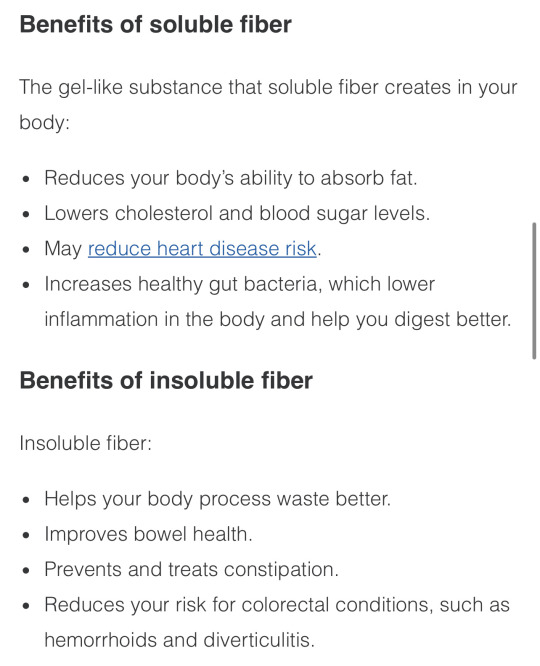
and just so we’re clear on the benefits of upping your fiber intake:
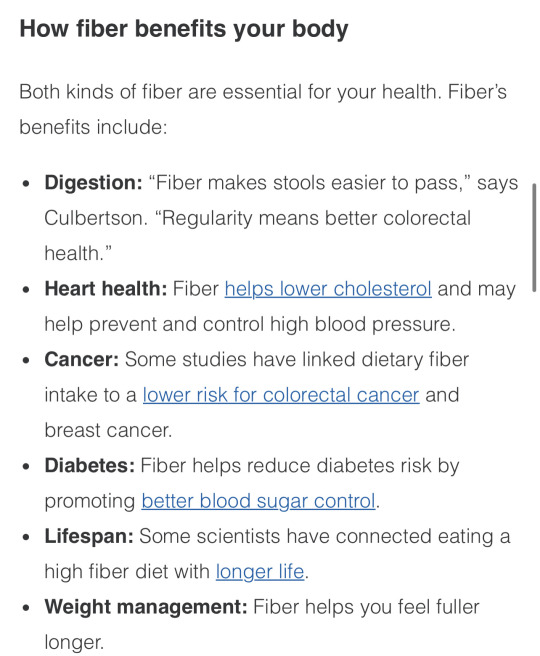
so!
i recommend a quick google to see the fiber content per serving of a variety of foods that i don’t have time condense here. but, like, beans are a really inexpensive way to do this (add some rice to it and you have a complete muscle-lovin’ protein btw! all the essential amino acids are covered when you combine rice and beans 🫶). beans and legumes are incredibly rich in fiber, and they’re budget-friendly, shelf-stable, and easy to make and easy to incorporate into infinite delicious possible dishes.
but your fiber can be gotten from so many different sources! (my data here is approximate from individual checking. pls allow 1-2g of fiber for margin of error in case i mistype!)
for fruits: 1 cup of blackberries OR raspberries has 8g of fiber!!!!! 1 medium apple has around 4-5g of fiber. an average banana or a serving of strawberries have 3g of fiber. an average avocado has 10g of fiber. and so forth
for grains: steel-cut oats have 5g of fiber per 1/4 cup uncooked (oats are generally rich in fiber anyway, but steel cut in particular). a slice of whole grain bread should have around 3g fiber. brown rice contains 3.5g fiber for every cooked cup. one cup of cooked quinoa (which is also a complete protein!) contains 5g of fiber. bran is almost 15g per one cup serving.
if you’ve got access to chia seeds, a 1oz serving provides 10g fiber. here’s a yummy super easy recipe for peanut butter chia pudding!!!
nuts and seeds provide a lot of fiber too. 1oz of walnuts contains nearly 2g fiber! 1oz of almonds contains 3.5g fiber. peanuts contain 2.5g fiber for 1oz. sunflower seeds are 12g per 1 cup serving (though that’s a lot of them to eat—1/4 a cup would be closer to 3g)
and my fave prunes are 12g per one cup serving. again, that’s a lot of them to eat. 1/4 of that would be 3g.
beans/legumes are king for fiber. 1 cup of cooked black beans contains 15g of fiber. 1 cup of navy beans contains around 19g of fiber. 1 cup of kidney beans contains 11g of fiber.
split peas are i think around 8g per cup when cooked? cooked broccoli is around 5g. corn is around 4g.
i could go on but i’m literally hooked up to an IV for medication rn so i’m one-handed lol i apologize for how cramped this is
but here’s a great list from the Mayo Clinic of high fiber foods and another list of 40 foods from a women’s health mag and also another from healthline, which also has a handy chart for fiber requirements for more specific age groups based on sex
and yes, there are also high-fiber cereals, but beware of the much-touted and rightly-feared ingredient of psyllium husk. it’s more or less used as a laxative and can be outright dangerous for your digestive system and is very painful if not consumed in militant moderation. ask me how i know lol. please please be careful of psyllium husk. like, for real. just stay away from it altogether imo.
sorry this is a lot of discombobulated info, but again i’m one handed at the moment. but hopefully that helps a bit! fiber is linked to longevity and good colon health and that’s what i want for women forever
EDIT: go slow with this! if you’re not used to the recommended daily intake, you will need to gradually work up to this so as not to upset your gastrointestinal system. you may otherwise find yourself in discomfort. GO SLOW. add fiber-rich foods in small portions over time to allow your body to adjust. it is well worth the patience—but don’t overload your system by eating a ton of prunes and thinking you’re doing yourself any good that way. introduce gently and in moderation until you feel comfortable with how it makes your digestion feel!
107 notes
·
View notes
Text
Flood-battered farmers in southern Brazil wade through lost harvests

After three days of ferocious rains, Edite de Almeida and her husband fled their flooded home in early May and let loose their humble dairy herd on higher ground. Nearby, the waters rose above her head and within a day they were lapping at the roofs of houses.
Record-breaking floods in southern Brazil, the result of weather patterns intensified by climate change, have only started to recede after displacing half a million people in the state of Rio Grande do Sul and killing more than 160.
The full extent of the losses is still coming into focus, especially in rural areas where farmers like Almeida and her family produce much of Brazil’s rice, wheat and dairy.
Of her 60 egg-laying hens, just eight survived. Their cows have nowhere to graze in the flooded landscape.
“I’m not mourning. I’m grateful, because there are many who lost far more than us,” Almeida said. “I’m grateful we survived and I mourn for those who lost family.”
Theirs were among the nearly 6,500 family farms flooded by this month’s torrential downpours, according to analysis of satellite data by consultancy Terra Analytics.
The floods have rattled agricultural markets as they disrupted soy harvesting, washed out silos, snared farm exports and killed over 400,000 chickens. The government is lining up rice imports to blunt the impact on national inflation figures.
Continue reading.
#brazil#brazilian politics#politics#environmental justice#economy#rio grande do sul floods 2024#farming#mod nise da silveira#image description in alt
6 notes
·
View notes
Text
Proto-bracket Poll 3:
Descriptions:
The Living Room (Shaperaverse): It was Made by Scientists along with some talking animals but they Ended Up running away. It isn't super important to the Plot but it is Friends with some characters Like a group of thieves (Made Up of two eighteen year old women, their pet Albatros Simon and a brilliant Mouse named sam) it also keeps one character company while he's trapped for a Bit and loosing His mind
Rice Fish (she/her, Red Scholar's Wake): She's a sentient ship who leads a band of pirates and kidnaps a data analyst to help her discover who's responsible for the death of her wife.
Cabeswater (the Raven Cycle): A magical sentient forest. The characters mostly refer to it as it and try to speak to it respectfully. The wonderful thing about TRC is that there is magic in the world! The terrible, dangerous thing is that there is magic in the world. How far does it stretch? Can you assume every tree is sentient? If Cabeswater can distort time and direct you where it wants you to go, what are its intentions? It does help the characters, but it asks something in return, and it doesn't communicate like humans so it takes a while for them to figure out what it wants and how to negotiate. Key quote: "If I were a tree, I would have no reason to love a human."
43 notes
·
View notes
Text
Chapter 211 Trivia
Try not to choke, dear Ryusui…

Going by the map and the several smaller islands, the KoS seems to have landed in South Kalimantan on the island of Borneo. The mountains in the background could be the Meratus mountains.


Indonesia is the world's second largest producer of rubber. The largest is Thailand which, geographically, isn't that far away, but it produces much less rice. This is probably why Indonesia was chosen for Rubber City instead.

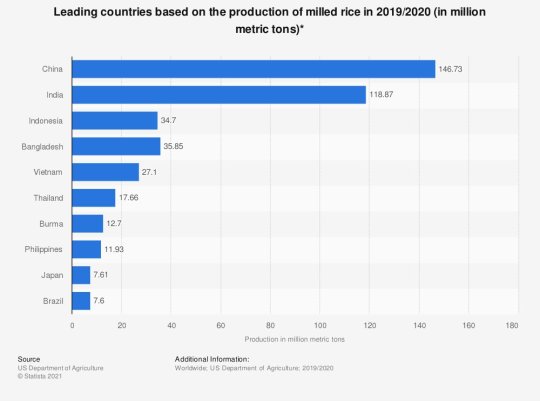
It's been 10 years since the KoS began the world tour:
-September 5741, Perseus completed
-January 5742, ground zero
~February, petrified for 7.5 years
-October 5750, arrive in India
-April 5751, arrive in Indonesia
-120 days for rice to grow, so it's around July/August.




It's a shame we didn't see traditional Australian dishes such as Vegemite, fairy bread, kangaroo meat…

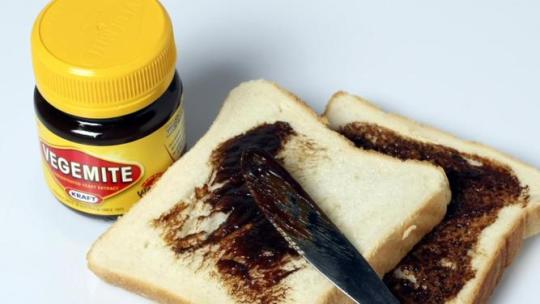

Rice grows from seed to harvest in ~120 days, so Indonesia can have 3 growing seasons. The most important one is the wet season from October to December, which is harvested in March & April. This is ~45% of total rice production for the year, which is the one the KoS harvested.

Character development.
(Gen finally tied up his cloak to stop it getting wet.)


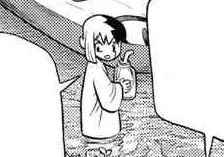
There's a lot of rice-based food in this image, so here's a few I've identified in case you need ideas for dinner.
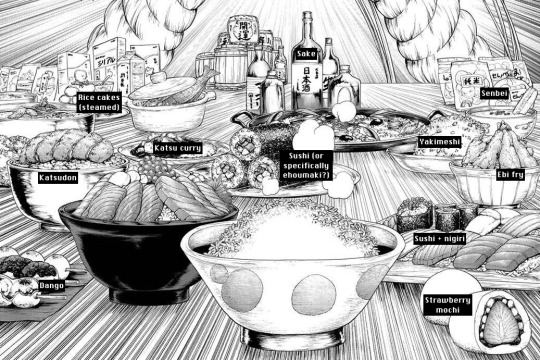
Chrome and Suika are surveying the land, presumably plotting (rice) paddies. Chrome is using a theodolite, which is used to measure angles on the horizon. Suika is probably measuring distance with the rope as extra data for their calculations.


Sai's lesson seems to be proving Heron's formula using Pythagoras' theorem.
We can also see that Chrome's handwriting has improved since the last time he had to calculate the properties of triangles!


The device Kaseki built is an Archimedes' screw, which can be used to lift liquids or sand-like mediums upwards onto higher levels. In this case, it's being used to fill the rice paddies.
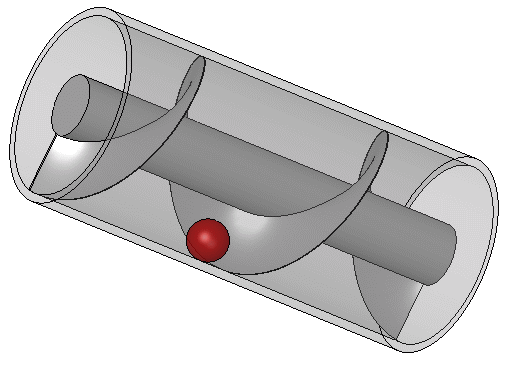
The mobile lab is truly one of the most valuable and hardworking members of the Kingdom of Science.

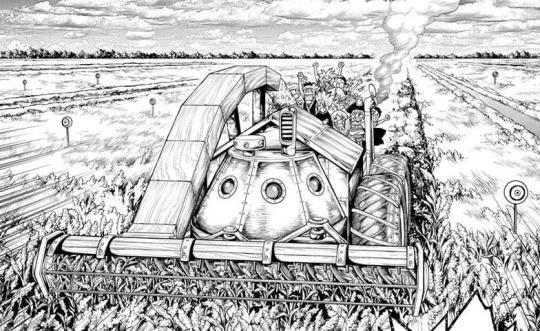
Nauru is one of the three great phosphorite islands in the Pacific Ocean, though thanks to too much mining in the last hundred years, the resource is almost completely depleted.
The prevalence of phosphorite is due to the albatross droppings, as Ukyo said.


When Yo said they took a pit stop, this is likely the route they took.

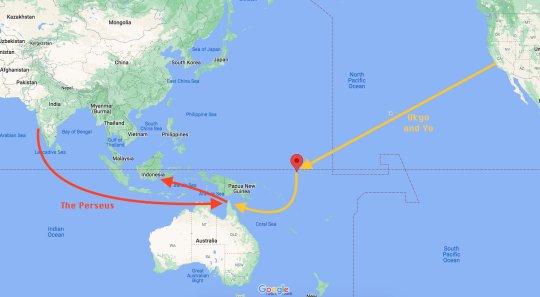
Fertilizer has 3 primary nutrients that help most plants to grow:
-Nitrogen, from the nitric acid
-Phosphorus, from the phosphorite
-Potassium, from the wood ash (this also has calcium carbonate, which, as we all know, has at least 4 uses.)

Rice has many different variants such as Japonica ("from Japan") and Indica ("from India"). Indica rice tends to be thinner and longer, and includes basmati and jasmine.
Amylopectin is a component of starch, and is what allows rice to stick to itself (necessary to make onigiri).

12 notes
·
View notes
Text
What 12 foods stop diarrhea?

The presentation makes way for unwinding the secrets of loose bowels and grasping its effect on our regular routines. In this shrewd excursion, we dive into the domain of stomach-related well-being, investigating the causes and side effects of loose bowels to lay out an underpinning of information. The runs, frequently excused as a typical bother, become the overwhelming focus as we perceive their importance and the requirement for compelling cures.
As we set out on this investigation, we unwind the complexities of a looseness of the bowels accommodating eating regimen, stressing the job of nourishment in lightening side effects. With a focus on the 12 food varieties that stand as champions against the runs, the acquaintance fills in as a passage with a reality where bananas, rice, and probiotic-rich yogurts arise as legends in the fight against stomach-related uneasiness.
The presentation not only goes about as a compass directing perusers through the forthcoming bits of knowledge but additionally highlights the significance of looking for suitable clinical consideration when important. It's an encouragement to find a comprehensive way to deal with overseeing the looseness of the bowels, offering trust and pragmatic arrangements that engage people to assume responsibility for their stomach-related prosperity. This isn't simply an investigation of food sources but an excursion towards understanding and vanquishing a typical sickness that influences all of us.
"Grasping Loose Bowels" unwinds the complex snare of this normal yet frequently misjudged gastrointestinal condition, offering extensive knowledge of its different features. Inside this investigation, we analyze the definition and side effects of loose bowels, revealing insight into the uneasiness it brings and the effect it can have on our day-to-day routines. As we explore through the normal reasons for the runs, the shroud is lifted on a condition that rises above simple bother, requesting our consideration and understanding.
This part fills in as a guide of information, engaging perusers to perceive the signs and side effects, and cultivating a proactive way to deal with their stomach-related well-being. The consideration of critical data on when to look for clinical consideration adds a layer of reasonableness, guaranteeing perusers are exceptional to settle on informed conclusions about their prosperity.
"Figuring out The Runs" isn't simply a part of our investigation; it's a basic point of support that makes way for a more profound understanding of stomach-related wellbeing. It welcomes perusers to disentangle the secrets behind this predominant condition, cultivating mindfulness and information that rises above the limits of inconvenience, at last making ready for powerful administration and counteraction systems.
"The Job of Diet in Overseeing Loose Bowels" becomes the dominant focal point as an essential part as we continue looking for stomach-related health. Inside these smart pages, we uncover the significant effect of dietary decisions on mitigating the side effects of looseness of the bowels, changing what we eat into an incredible asset for recuperation. This part enlightens the idea of a looseness of the bowels accommodating eating routine, where each piece turns into an expected cure.
Perusers are directed through the significance of choosing the right food varieties and creating an eating regimen that sustains as well as effectively adds to the help of stomach-related distress. The job of sustenance turns into an encouraging sign, offering functional answers for people looking for normal cures.
As we explore this dietary scene, the part accentuates the harmonious connection between food and the side effects of the executives, giving perusers the information to pursue informed decisions. It's an excursion into the core of sustenance, where the right food sources become partners in the fight against loose bowels.
"The Job of Diet in Overseeing Looseness of the Bowels" rises above the standard way of thinking encompassing dietary decisions, introducing a guide for perusers to recover command over their stomach-related well-being. It's a story of strengthening, where the plate turns into a material for mending and prosperity.
"12 Food Varieties to Stop Looseness of the Bowels" unfurls as a culinary cure guide, offering a delightful cluster of nature's arrangements to battle stomach-related trouble. Inside these pages, find the influence of probiotic-rich marvels like yogurt and kefir, developing an agreeable climate inside the stomach. The Rascal diet takes the spotlight, exhibiting the mitigating capacities of bananas, rice, fruit purée, and toast - a group of four of culinary healers.

This part wanders into the domain of restricting food varieties, where bubbled potatoes, white bread, and plain wafers arise as immovable partners, giving a strong groundwork to stomach-related strength. Clear liquids become the elixirs of hydration, with stock-based soups, homegrown teas, and electrolyte-rich beverages guaranteeing a decent way to deal with battling the runs.
Perusers are not simply given a rundown but rather are welcomed on a gastronomic excursion, investigating the flavors and surfaces that can be outfitted for stomach-related prosperity. This assortment of 12 food sources is an ensemble of tastes, fastidiously organized to bring help and solace. It changes the kitchen into a shelter of recuperating, where every fixing is a possible remedy to the runs' uneasiness.
"12 Food Sources to Stop The Runs" isn't simply a rundown; it's a culinary solution, a festival of the different and scrumptious choices accessible to those looking for a characteristic solution for stomach-related diseases. It's a gastronomic manual for reestablishing harmony and enjoying the kinds of well-being.
The Rascal diet comprises tasteless and effectively edible food varieties that are frequently suggested for people encountering stomach-related issues, especially during episodes of the runs. The name "Whelp" is an abbreviation for the four primary parts of the eating routine:
Bananas: Bananas are rich in potassium, which is significant for keeping up with electrolyte balance in the body. They are effectively edible and add to firming up stools.

Rice: White rice, specifically, is a staple of the Rascal diet. It is a boring, low-fiber food that helps tie stool and decrease the recurrence of defecations. Earthy-colored rice is ordinarily kept away from it because of its higher fiber content.
Fruit purée: Unsweetened fruit purée is delicate on the stomach and gives a wellspring of energy without presenting extreme fiber. It tends to be relieving for a bothered stomach-related framework.
Toast: Plain, white toast, or saltines are remembered for the Whelp diet for their tastelessness and low fiber content. They can assist with retaining an abundance of liquids in the gastrointestinal system, giving help from the looseness of the bowels.
The Whelp diet is frequently suggested for transient use during episodes of intense loose bowels or stomach upset. It is fundamental to once again introduce a more adjusted and differed diet when the stomach-related framework starts to balance out, as the Rascal diet alone may miss the mark on fundamental supplements for long-haul healthful requirements. Continuously talk with a medical care proficient for customized guidance on overseeing stomach-related issues.

Restricting food varieties are those that can assist with firming up diarrheas and lessen the recurrence of defecations. These food varieties are frequently suggested for people encountering loose bowels or other stomach-related issues. Restricting food sources are ordinarily low in fiber and simple to process, planning to give alleviation to the gastrointestinal framework. Here are a few instances of restricting food sources:
White Rice: Effectively edible and retains an overabundance of water in the digestive organs, advancing firmer stools.
Bananas: Wealthy in potassium and gelatin, bananas can assist with building up stool and give fundamental supplements.
Fruit purée: Unsweetened fruit purée is delicate on the stomach and can add to firmer stools.
Plain Toast or Wafers: Low-fiber starches like plain white toast or saltines can be kind with the stomach-related framework and assist with an engrossing abundance of liquids.
Bubbled Potatoes: Bubbled or pureed potatoes without added fats or flavors can be restricting and give a decent wellspring of energy.
Smooth Nut Spreads: Rich nut margarine, similar to peanut butter or almond margarine, is low in fiber and can assist with adding calories without irritating the stomach-related framework.
Cooked Carrots: Very much cooked carrots are low in fiber and may assist with restricting stools.
It's vital to take note that while these limiting food varieties can be useful in the present moment for overseeing loose bowels, an even eating regimen with various supplements is essential for general well-being. On the off chance that stomach-related issues continue or deteriorate, it's prudent to talk with a medical care professional for legitimate determination and direction.

Clear liquids assume a pivotal part in keeping up with hydration, particularly during episodes of loose bowels or different circumstances that lead to expanded liquid misfortune. Clear liquids are handily consumed by the body and can assist with forestalling drying out. Here are a few instances of clear liquids that are regularly suggested for hydration:
Water: Plain water is the most fundamental and viable liquid for remaining hydrated. It replaces lost liquids and supports by and large physical processes.
Stock-based Soups: Clear stocks, like chicken or vegetable stock, give hydration as well as fundamental electrolytes like sodium and potassium.
Homegrown Teas: Non-energized natural teas, like chamomile or peppermint tea, can be mitigating and hydrating. These teas are in many cases gentler on the stomach.
Clear Natural Product Juices: Weakened and unsweetened natural product juices, similar to apple or white grape juice, can give hydration and a wellspring of basic sugars.
Electrolyte-rich Beverages: Business electrolyte arrangements or natively constructed electrolyte beverages can assist with renewing electrolytes lost during the looseness of the bowels. These may incorporate a blend of water, salt, and sugar.
Coconut Water: Wealthy in electrolytes, coconut water is a characteristic and hydrating choice that can be particularly gainful during episodes of looseness of the bowels.
It's fundamental to focus on liquid admission to forestall drying out, and clear liquids are liked during seasons of stomach-related furious as they are less inclined to bother the stomach. Nonetheless, assuming that loose bowels continue or are joined by other side effects, looking for clinical guidance for proper management is significant.
Exploring loose bowels and accommodating an eating routine doesn't mean thinking twice about flavor or assortment. "Ways to Integrate These Food Sources into Your Eating Routine" fills in as your culinary compass, directing you through a consistent coordination of recuperating fixings. Embrace the flexibility of bananas, whether cut on morning grain or mixed into a relieving smoothie. Hoist plain rice by matching it with bubbled potatoes, making an encouraging and effectively edible team. Change toast into material for innovativeness, spreading smooth nut margarine or fixing it with pounded bananas for a wonderful contort.
In this culinary experience, segment control becomes the dominant focal point, guaranteeing an equilibrium that supports without overpowering the stomach-related framework. Find the craft of slow renewed introduction, permitting your body to adapt to a different eating regimen as it mends. Investigate cooking methods that upgrade absorbability, transforming these limiting food varieties into culinary enjoyments that give pleasure as you would prefer buds.
As you leave on this delightful excursion, recall that effortlessness is vital. From integrating fruit purée into baking recipes to imbuing clear stocks with spices for an exquisite kick, these tips implant your dinners with both mending properties and flavor. "Ways to Integrate These Food Sources into Your Eating Routine" is your guide to making feasts that sustain your prosperity while embracing the variety of flavors that the runs accommodating eating routine can offer.
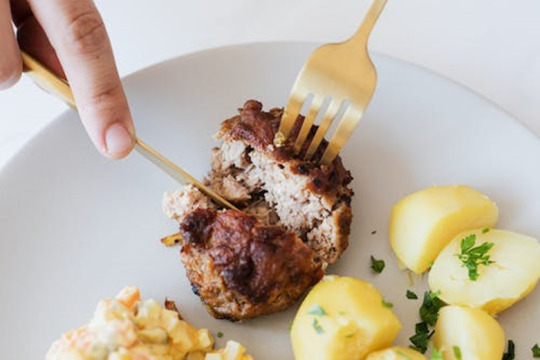
"Food Varieties to Stay Away from During Looseness of the Bowels" reveals insight into the dietary guilty parties that can compound stomach-related trouble, filling in as a cautious manual for avoiding possible triggers. This segment reveals the bad guys in the gastronomic story, alerted against dairy items known to deteriorate the looseness of the bowels because of lactose prejudice. Fiery food sources, frequently celebrated for their flavors, assume a lower priority in this story as their capability to disturb the gastrointestinal system is investigated.
High-fiber food sources wind up on the rundown of enemies, their unpleasant surfaces and inedible characteristics fit for increasing side effects. Oily or broiled food sources, celebrated for their liberal allure, are exposed as potential disruptors to a delicate stomach.
As perusers set out on this illuminating excursion, they are furnished with the information to pursue informed decisions, guiding away from carbonated refreshments that can add to bulging and distress. This investigation into the "Food varieties to Keep away from During the Runs" is certainly not a simple restriction however an encouragement to develop a careful way to deal with dietary determinations, advancing recuperating, and help from gastrointestinal misfortunes. With this culinary compass close by, perusers can explore the dietary scene with certainty, pursuing decisions that help stomach-related prosperity and prepare for a swifter recuperation.
#healthy eating#weight loss diet#i wanna lose weight#healthy diet#weight lifting#fitness and exercise#healthy living#fitness tips#weight loss#weight loss program#health & fitness#fitness#healthy#nutrition#workout#fitnessmotivation#strength training#healthy food
7 notes
·
View notes
Text

Sonji Arashi
Age: 40
Voiced by:J. Michael Tatum
Height: 200cm
"Family": Jack Atlas (Son), Sumire Atlas (daughter)
Occupation: Council member, Chairman of the CRANE Foundation.
Innate: Lighting Spear
Style: Suits
Flaws: Selfish,cruel,Cold,power hungery
Favorite food: Rice bowls
Least favorite food: Sushi
Personality
Sonji is a firm believer in Darwinism. He believes that only power is the most important thing in the world. As such,he sees people as his experiments. If you aren't powerful,well you're nothing to him. He'll take an interest if you have potential. He'll even help you unlock it. Whatever you want to or not
Skills
Manipulation
Data Spear: This magic allows him to gain control of any magical item he sees
Intelligence
Trivia
Sees Vivian as a equal due to her cunning
Was the one who started the Rain project.
Sees Neo Domino as a foolish place
Knows about the miraculous. Don't care for them
Wonders why Kai would though all the trouble for 2 kids
@anxious-twisted-vampire @insomniac-jay @abyssthing198 @marrondrawsalot @nproduction626 @achy-boo @writing-heiress @gritsandbrits @kousaka-ayumu @liviavanrouge
11 notes
·
View notes
Text
In 2020 the top exporters of Rice were India, Thailand, Vietnam and Pakistan and the top importers are China, Saudi Arabia, Philippines, United States and Iran. Download rice exporters importers details.
0 notes
Text
STORY AT-A-GLANCE
While insulin resistance is routinely identified as a root cause of most chronic diseases, it too is only a symptom of a deeper problem. At the root will be impaired cellular energy production in the mitochondria
Insulin resistance occurs when the cells are unable to properly oxidize or burn glucose
When your body shifts into fat burning this results in lowering your metabolic rate, which is antithetical to optimal health. For optimal health, you need a high metabolic rate, and this is facilitated when your metabolism speeds up when you’re burning glucose in your mitochondria
A general baseline for most average-sized people is between 150 grams and 250 grams of healthy carbs per day. If you’re very active, it could be as high as 500 or 600 grams a day. Keep in mind that as you increase carbs, you also need to cut down fat. Fat intakes above 30 to 40% or so of daily calories will tend to inhibit glucose metabolism
Healthy carb choices include fresh whole fruit, fruit juice, root vegetables such as potatoes, sweet potatoes, parsnips and carrots, white rice, raw honey and maple syrup
In this video, I interview independent health researcher Jay Feldman, who has a podcast called "The Energy Balance Podcast." I recently came to understand the importance of the late Ray Peat's work, which I had previously dismissed for over three decades, largely due to confirmational bias.
Peat was a biologist and physiologist, and a cofounder of the prometabolic diet based on the bioenergetic theory of health.1 After re-exploring his work, I’ve come to realize just how ahead of his time he was. Feldman is among the few health researchers out there who has also embraced Peat’s work and understands it at a level that allows him to explain it in layman’s terms.
As some of you may know, I’m in the process of creating a master class in preparation for the next pandemic crisis, which I believe is inevitable, and it became obvious to me that Peat’s work is a really crucial component of being metabolically resilient and prepared for the next crisis.
You don’t have to wait for my master class to learn about Peat’s work, however. You can just dive into Feldman’s podcast. There are more than 100 episodes and I suggest starting at Episode 1 and working your way up. Feldman does a terrific job teaching you how to easily and practically implement these strategies.
What Causes Disease?
Well before I encountered Peat's work, I was convinced most chronic disease was rooted in insulin resistance. I still think that's a primary problem, but I’m convinced it’s not caused by excess sugar. High linoleic acid (LA) levels are the primary factor that drives insulin resistance, and LA is clearly far more damaging than sugar, especially in the long term.
As explained by Feldman, insulin resistance occurs when the cells are unable to properly oxidize or burn glucose, resulting in a backlog of glucose metabolites and a buildup of glucose in the cells, along with the production of lactate.
This forces the cells to rely on fatty acid oxidation, and the combination of fatty acid oxidation and glucose buildup prevents the cells from taking up more glucose, causing elevated blood sugar. It’s a symptom of a deeper problem, namely impaired energy production in the mitochondria:
"I always come back to the idea that the amount of cellular energy available is what's going to drive our health, and the lack of energy is what's going to lead to disease processes, dysfunction, degeneration.
When it comes to insulin resistance, I think there's a bit of a misnomer. It's a helpful term for encapsulating a larger idea, but we get caught up in the idea of insulin.
If we're going to say that there's one driver [of disease], it’s typically a lack of energy caused by issues with energy production, or inefficiencies in producing energy, due to mitochondrial dysfunction, and that causes insulin resistance.
Those things go hand in hand. When we're talking about insulin resistance, we're talking about a situation where the cells aren't able to properly use glucose, so the glucose builds up. And regardless of how much insulin we have, it's really hard to get more glucose into the cells, and we see rising blood sugar and all of the other downstream effects.
So, insulin resistance is there. I think it's just a matter of what we call it. Do we call insulin resistance the fundamental problem, or energy dysfunction — low metabolism issues with energy production?
From my view, I would say that's where we start, and insulin resistance is an effect of that. And the only reason why I would make that distinction is because we can get caught up in the idea that insulin is the problem and things that increase insulin will cause the cells to stop responding to insulin.
We need to figure out why the cells aren't responding to insulin, and if we get down to that deeper layer, it comes back to an issue with producing energy."
That said, Feldman agrees that fasting insulin is a good marker for health, in that it provides you with a good estimate of the efficiency of your cellular energy production. So, provided you’re consuming a healthy amount of carbohydrates, your fasting insulin is a good marker for how well you’re using that glucose and how well you’re producing energy.
Understanding the Underlying Problem
Just keep in mind that while you can lower your fasting insulin by avoiding carbs, that won’t fix the underlying energy production problem. In fact, if you’re on a low-carb diet, you’re causing insulin resistance. Sometimes you might not realize it because your insulin and glucose levels are so suppressed. Eventually, however, you might notice that your glucose level starts to rise.
As explained by Feldman, the underlying problem is not that you’re eating too many carbs. It’s that you cannot properly burn carbs. That’s what caused your glucose and insulin levels to be elevated in the first place. Cutting carbs will lower glucose and insulin, making it appear that all is well, but can you burn carbs? That’s the question.
If you’ve been on a ketogenic diet for some time and are experiencing deleterious effects like sleep disturbances, anxiety, a drop in testosterone and/or T3, reduced energy and exercise performance, then you may have "stealth insulin resistance."
In other words, your cellular energy production is fundamentally impaired and the low-carb diet was just a Band-Aid masking the symptoms. The real problem persists, because carbs were never the driver of insulin resistance in the first place. An inability to properly oxidize (burn) the carbs was.

Download this Article Before it Disappears
Download PDF
How to Safely Add Carbs Back In
So, how do you bring carbs back in so that you actually improve your ability to use them and minimize negative effects? First and foremost, avoid omega-6-rich polyunsaturated seed oils, as they effectively interfere with energy production and the utilization of glucose. Instead, use monounsaturated and saturated fats.
Next, add carbs back in very slowly, to allow for the upregulation of enzymes that increase carb utilization and conversion to energy. Start by adding easily digestible carbs that won’t cause intestinal irritation or endotoxin production, such as whole fruits.
If you have microbial overgrowth in your gut, you’re producing a lot of endotoxin. In this case, you need to be careful about introducing fermentable carbohydrates, including fruit fibers, so fruit juice may be a better choice than whole fruit. Just be mindful of the juice you select. Apple juice, for example, has fermentable carbs.
Assuming you don’t have an underlying digestive problem, whole fruit is a great place to start. If you start eating whole fruit and notice an increase in gas or bloating, gurgling or belching, or if you feel sluggish or lethargic afterward, you likely have an intestinal issue such as SIBO (small intestinal bacterial overgrowth). You can also try having whole fruit sometimes and fruit juice at other times and see if you notice a major difference.
"If you feel a lot better with the fruit juice, then that's a pretty clear sign that you are having some issues with fermentable carbohydrates," Feldman says. In this case, you need to restore your microbiome before you add in more carbs. In the interview, we also discuss the use of antibiotics, either herbal or pharmaceutical, to treat small intestinal bacterial overgrowth (SIBO), so for more information on that, listen to the interview.
"Typically, we want [gas and bloating] to be minimal. This is central. In the same way we can't overstate the importance of avoiding PUFA, we cannot overstate how much endotoxin — these bacterial byproducts — destroy your health.
You see it in every chronic health condition. In every degenerative condition you see this mild endotoxemia. You see it in fatty liver disease and diabetes, obesity, atherosclerosis.
This is one of the main reasons why people feel better on a low-carb diet or when they're fasting. They're avoiding anything that's feeding the [bacteria in the] intestines. So, if you are one of those people who felt way better and lost weight and noticed a bunch of improvements [on a low-carb diet], there are two main reasons why that would be the case.
One is reductions in endotoxin ... The other possible reason is, if they were extremely insulin resistant going in, they were having a lot of trouble using glucose, and so switching to fat and ketones led to a lot of relief.
That's likely also a situation where your utilization of the carbohydrates is going to have to be ramped up slowly, and your capacity for that might be a little bit lower. So, we want to work on resolving that issue. It could be caused by endotoxin, polyunsaturated fats, by nutrient deficiencies, a lack of sleep and other forms of stress.
If you didn't have these major benefits on low-carb, you might be able to bring in the carbs much faster and feel much better quicker. But that's why it's all dependent on the individual's context."
Quick Summary of How to Start
Feldman recommends starting with one piece of fruit with each meal for a week or two. If your appetite increases and you feel better overall, that’s a good sign that your metabolic rate is increasing. As long as you’re feeling good, increase to two pieces of fruit per meal and go from there. If you’re having negative effects, decrease your intake and go slower.
Feldman suggests the baseline for most average-sized people is between 150 grams and 250 grams of healthy carbs per day. If you’re very active, it could be as high as 500 or 600 grams a day. Keep in mind that as you increase carbs, you also need to cut down fat, as fat intake above 30 to 40% or so of daily calories will inhibit glucose metabolism. Other healthy carb choices include:
Organic dried fruits without added sugars, additives or preservatives
Root vegetables: potatoes, sweet potatoes, parsnips, carrots
White rice (well-cooked) and ideally consumed with saturated fat to prevent the rice from feeding bad bacteria
Raw honey
Maple syrup
Carbs that may be tolerated by some but not others include grains that are traditionally processed, fermented, soaked and/or sprouted. Sourdough bread is one example. On the more harmful end are unprocessed whole grains and brown rice, as they’re high in anti-nutrients that impair all aspects of digestion.
They contain anti-nutrients like trypsin and amylase inhibitors, phytic acid and oxlates, which can inhibit the digestion of protein and starch while also reducing vitamin and mineral absorption. Most grains are also high in LA. And, of course, processed foods are also on the list of carbs to avoid.
Troubleshooting
Hopefully, if all goes well, you’ll make this transition and realize that both your glucose and fasting insulin are still at healthy levels, or maybe even lower than before. But what if you’ve made the transition to a higher-carb, lower-fat diet, and still have a fasting insulin level of 7 or 8?
Ideally, it should be below 3. Maybe you’re also gaining weight and still feeling sluggish. What’s going on? In short, these are all signs that you’re still metabolically inflexible. So, now what?
"There are a number of things I would go to," Feldman says, "but again, the question is, what is causing the issue with [not] converting those carbohydrates to energy?
We talked about endotoxin being a huge one. If someone's already cut out the polyunsaturated fats, endotoxin is really common, so we want to make sure that we've fixed everything up gut-wise. If not, that would be my target.
If that's doing pretty well, and we're generally not overstressing, we're getting some good comfortable movement in, we're eating carbohydrates from the right sources, and we're still not seeing the benefits that we were looking for, we're still not seeing the restoration of insulin sensitivity, then I might look for some other support for glucose metabolism.
That could be B vitamins ... I know you've talked a lot about niacinamide. Thiamine is another one that is crucial for producing energy from carbohydrates ... Supplementing with those would be potentially warranted there.
I would also look at other hormonal indications. I'd look at thyroid status at that point, because if we've made some of these shifts but we're not seeing the conversion from T4 to T3, or we're not seeing good thyroid hormone production, that could be a higher level issue that's causing a ton of things farther down the chain, and that can include insulin resistance.
If that's the case, I would look toward doing everything we can to restore that ... I would also look at the steroid sex hormone production for women, maybe there’s too much estrogen, maybe not enough progesterone. That can be another huge factor here that can drive or contribute to insulin resistance.
For men, I'd be looking at low testosterone. There's certainly a place for things like pregnenolone, progesterone, maybe a bit of DHEA to help support that hormonal state as well."
Why Glucose Is the Ideal Fuel
As explained in the interview, glucose is the optimal fuel for creating energy in your mitochondria. Two byproducts of that process are metabolic or deuterium depleted water, and carbon dioxide. While commonly thought of as a waste product, Peat has made abundantly clear that carbon dioxide is a massively important molecule, and a far superior vasodilator than nitric oxide.
When you are low on carbon dioxide, you can't be optimally healthy, and if you're oxidizing (burning) fat in your mitochondria rather than glucose, you're not going to generate as much carbon dioxide, which also protects proteins from being glycosylated, and lipids from being oxidized. Carbon dioxide also counteracts ROS and RNS (reactive nitrogen species). That’s not the only reason glucose is a better fuel than fat, though. As explained by Feldman:
"I think it's always helpful to put this in the larger biological context. In any situation where we are starved, where we're under major stress, when things are dysfunctional, we shift into fat oxidation, fat burning. And this includes when we're not eating anything. This is why when we're fasting, we will shift into ketosis, and we can mimic those states by going on a low-carb, high-fat diet, and low protein.
The biological context there is that our bodies view that as a situation when we're under stress, when we don't have a lot of fuel available, when we’re in a famine, when we need to survive for a long period of time. In a situation like that, we want to decrease our metabolic rate.
We don't want to use a lot of energy on reproduction, cognition, digestion, growth and repair. We want to conserve energy because we don't know when we're getting food. So, everything around fat burning involves a slowing of the metabolic rate, and we see this again on that bigger picture level.
We see it when we look at thyroid hormone conversion, which gets impaired when we're low in carbohydrate intake. We see it in terms of testosterone, and we also see it on the mitochondrial level, because on the mitochondrial level, that's where this all starts.
That's how our body senses whether it's burning the fats or the carbs. When it's burning fats, it has a number of different places that slow down the actual respiration, that slow down the conversion from the fats to energy. And again, this is all healthy and adaptive in that it allows us to survive if we're starving.
But it's not ideal for thriving. It's not ideal for optimal function. It's not ideal for reproduction. Our bodies don't want to reproduce if there's no food available. It's not ideal for high-level cognition.
When we zoom into the mitochondria, what we see is that the primary difference between glycolysis, the starting of burning carbs and the bad oxidation of the fats, is a difference in the amount of NADH and FADH2 that gets produced.
And when we finish out through the Krebs cycle, and then go to the electron transport chain, depending on the length of the fatty acid, there will be considerably more, sometimes 250% more FADH2 relative to NADH than if we were to oxidize glucose.
What happens is, because we have this major drop off of electrons at Complex 2 through the FADH2, relative to Complex 1, we end up with reverse electron transport. [This is] reductive stress, and that's because Complex 1 and Complex 2 both use the CoQ electron acceptor.
If you're favoring Complex 2, you're going to reduce the amount of electrons that can be dropped off at Complex 1, and you're going to reduce the amount of electrons at Complex 1 that can keep going down the chain.
So, you get a buildup there, and you get this reverse electron transport and major production of ROS at Complex 1. The other thing that happens is, because of this buildup at Complex 1, the NADH can't drop off its electrons, so you get buildup of NADH, relative to NAD.
Our bodies are really smart when they see this, because this then affects everything further up the chain. It affects various steps of the Krebs cycle. There are three different steps that need the NAD, so each of those get reduced. So, we're slowing the activity through the Krebs cycle. We're getting buildup of citrate, for example, that increases the synthesis of fat, and that gets built up even further.
We end up with a buildup of acetyl-coA that reduces the conversion of pyruvate to acetyl-coA, which also is dependent on NAD, so we've got two ways that that's being inhibited.
And then when you look back up at glycolysis, there's a number of steps there that get inhibited as well due to this high NADH to NAD ratio, this highly reduced state of the mitochondria. That is just a part of the natural braking mechanism that happens to make sure that when we're burning fats, we're doing it slowly. We also produce a lot of ROS, which slows this down.
As a result of this, you'll eventually induce things like uncoupling, which will fully stop ATP production. So, we've got a number of different mechanisms that basically are signals. It's telling our body that when we're burning fats, we need to slow everything down, we need to slow our metabolic rate, and we're going to produce a lot more ROS. We're going to be slowing things down in the electron transport chain.
This is not ideal if energy is the currency of our health, if that's what allows us to function and get us out of this constant stress state ... That's the crux of this difference between the carb and fat burning. And then we have the CO2 as the cherry on top ... because it protects against the oxidative stress, or reductive stress, as well as being the main thing that oxygenates the cell, which keeps respiration going faster.
Again, that's another braking mechanism. The cell will take up less oxygen because it's producing less CO2, which it needs for that uptake of oxygen itself. I was in the low-carb sphere as well and got hooked on the idea that sugar burning is the one that's the unhealthy and produces all the oxidative stress and everything, but totally missed what's actually going on."
Simple Way to Gauge Your Metabolic Rate
Feldman also takes a deeper dive into how glucose and fat burning affects your thyroid function but, basically, when you burn fat in the mitochondria, you inhibit your thyroid gland, which in turn invites weight gain, as your thyroid is your main metabolic regulator.
So, the answer to many a sluggish thyroid is not thyroid hormone supplementation, but eating the correct fuel so that your body has the energy it needs, and your thyroid doesn’t need to downregulate your metabolic rate. He also notes that many people are simply not eating enough calories. Low-calorie diets will also suppress your metabolism, for all the same reasons as detailed above.
While the ideal amount of calories vary based on your age, metabolic rate, physical activity and more, as a starting place, Feldman suggests using a typical calorie calculator to estimate your daily calorie requirement, and if you’re eating fewer calories than that and are gaining weight or maintaining your weight, your metabolism is low.
After you’ve estimated your daily calorie requirement, calculate how much protein you need. The formula for that is 0.6 to 0.8 grams of protein per pound of lean body mass or ideal body weight. The amount of protein you need should be about 15% of your daily calories. Then divide the rest into 45% to 65% healthy carbs and 20% to 40% healthy fats. In closing, Feldman has the following advice:
"If someone's insulin resistant, they're not using the carbs coming in, and if they're not going to fix it, then sure, we might as well avoid carbs for a period of time. But I would say the better route is to work on fixing it. And in the vast majority of cases, the people who are in that state are not coming from a whole food, fruit, root vegetables, low PUFA fat sources type of diet ...
So my suggestion would be, just go to that. We don't even have to over-complicate it ... just shift toward whole food, low PUFA, easily digestible foods, away from the grains. For the vast majority of people that gets them to where they need to go without needing something as restrictive and inherently stressful as keto and carnivore.
If that is the only way for someone to move forward, if it's that or sticking with what they're doing, then yeah, do it. Do keto or carnivore. There is an inherent long-term negative to it. There's inherent stress that comes with it, but if that is the route that someone needs to go to make a change, then I think it's fine to start there. I would just say let's not stick with that long-term.
I'd really prefer to shift to including healthy carbohydrates as soon as possible. And that's because whether the stress is for three months or a year, it's always going to be a negative. What happens is, we have these major benefits from reducing the endotoxin, and relief from throwing carbs into an insulin resistant state, but once you've attained those benefits, the negatives will start to creep in.
I'd rather get all of those benefits without the negatives. I'd rather lower endotoxin by taking out grains and raw vegetables, raw leafy greens, those kinds of things, lowering fiber if we need to, but keeping carbohydrates so we can avoid the stress. I'd way rather get that benefit in that way as opposed to just taking out all carbohydrates."
More Information
To check out more of Feldman’s work, visit his website, JayFeldmanWellness.com. Again, I recommend starting with Episode 1 and working your way up for a life-changing, immersive-learning experience on implementing bioenergetic medicine. Each episode has show notes and links to studies cited. You can also listen to his podcast on Apple Podcasts, Google Podcasts, Stitcher and Spotify. Just search for "The Energy Balance Podcast."
9 notes
·
View notes
Note
*kicks down door* Alex from Discord here- give me headcanons for my main duo, Qi and Burgess. I need to know about them. I need more fuel for the fanfic fire.
🌻Burgess🌻
-Burgess gets antsy with leaving the task of watering the plants to anyone else and WILL make sure they do it by sneaking around and hiding behind shit
-one of Burgess’ favorite things is when Miguel asks for his help with weeding and planting new life near the church grounds. It’s one of their bonding moments
-Burgess’ favorite song is You Are My Sunshine. He sings it for various moods, and it alleviates his nerves just a little.
-it’s not something he tells the builder, but rather they find out on their own because he subconsciously does it. Singing it to him or when he’s around gives him this strong sense of peace and comfort. He doesn’t like to make a big deal about it but he appreciates it an overwhelming amount
-taking long walks around town and looking at the thriving plant life is one of his favorite things to do. Suggesting it as a date will make his entire day and he’ll think back on it for the rest of the week
-start pressing flowers in books with him! He starts to worry about those that are frail and weak. The ones that are helpless as soon as their stem is near snapped off and can’t be fixed. Start a journal where you press flowers in it and write about where it was from, the day the builder and him found it, what it symbolizes
-start looking into what flowers symbolize too! It’ll become a new hobby to share with one another
-pet names are great and all, but nothing is gonna make him feel more loved than calling each other by a flower as well. Like “My daffodil”, “my rose”, “blossom”, etc
-he won’t admit it, but he secretly wishes to have Macchiato for a pet. She’s just so cute and her fur is so pretty when she sunbathes between blades of grass. He’s got such a soft spot for her and unlike Banjo, she doesn’t eat at the plants.
-he actually surprisingly likes to link arms more than hold hands! There’s a certain closeness to the body it provides and feels more intimate. He’ll hold the builder’s hand, ofc, but he’s not prone to linking fingers together as one would think.
-he enjoys picnics between the small collected trees not too far from the builder’s workshop! It’s peaceful and shaded with the few plant life around
🚀Qi🚀
-just, just get an unlimited supply of tea.
-when he desperately needs sleep and is too preoccupied to truly notice anything, switch his mint tea out for chamomile. Literally, he’s too distracted to actually know
-he loves to talk about space and theories and all that when given the chance and time. The builder doesn’t have to know exactly what he’s talking about. But just listening and watching him makes him feel like the most important person alive
-keep an eye out for any data discs that are actually movies! While he prefers sci-fi, he’s actually really fascinated with the Old World and is willing to watch anything “for the sake of science”
-waltzing in during the mornings with a cup holder filled with hot steaming tea actually brightens his day significantly and guarantees a more approachable Qi
-he won’t admit it for years, but he just loves when the Builder comes in with a book and settles in while he works. It’s that peaceful silence he can bask in because he’s got their company to tune into.
-having the Builder close by alleviates a portion of his stress. When his mind feels too rattled with information and hypotheticals and equations. Even Qi needs a break sometimes. Having the builder within view for when his eyes drift up is a weird sort of peace he’s come to love.
-asking him what he’s doing and then the five W’s and “how” actually helps him refocus when he’s losing track. Sometimes it helps with a breakthrough.
-making him rice helps him throughout the day, but he still needs proper meals despite not requesting it. A lump sometimes forms in his throat though when he turns suddenly only to find a plate of food there that he hasn’t noticed before- a sudden burst of love flooding him as he eats because he has someone to do that for him now
-the Builder can convince him to go to a fireside meeting- he’s just gonna make it their problem by being a loveable frustrating little shit
-Qi actually knows when he’s getting on their nerves sometimes and does it purposely when he’s getting bored with his work. There’s something about seeing the fire in his significant other’s eyes that triggers the need to work even harder so he can pay attention to them fully afterwards
-if he’s stressed, the sudden presence of their hand in his messy hair loosens him up and prompts him to stop for a second, letting him breathe. The gentle movements and threading of their fingers eases his nerves
-believe it or not, if he were to own a pet, it’d be CoCo. He’s utterly fascinated by the owl and respects the bird more than the majority of the residents of Sandrock
#my time at sandrock#mtas#sandrock#pathea#sandrock builder#mtas builder#Mtas qi#Sandrock qi#Mtas burgess#Sandrock burgess#Mtas head canon#Sandrock head canon#ask box#siren speaks
29 notes
·
View notes